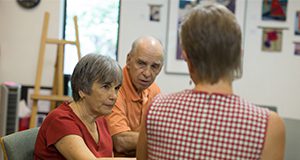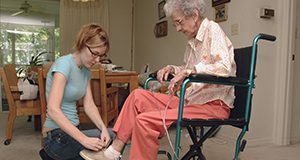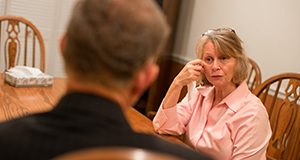Life is filled with uncertainty. When disasters or hard times arise, individuals often become vulnerable and feel helpless and confused. After the initial shock, people start to wonder how they can help. When we feel moved to donate, we should take steps to confirm that our gifts are going exactly where we intended them to go. This 3-page fact sheet discusses impulse giving, ways to avoid it, phone solicitations, mail fraud, resources for accurate information on charitable organizations, and steps to take if one falls victim to a scam. Written by Lynda Spence, and published by the UF/IFAS Department of Family, Youth and Community Sciences, August 2018.
http://edis.ifas.ufl.edu/fy1479
Tag: Lynda Spence
The Art of Goodbye: A Closer Look at Emerging Trends in End-of-Life Rituals
With increased access to information, survivors as consumers are seeking more alternatives to the conventional funeral. For some, tradition continues to inform, but for others, options are evolving and forming new possibilities. This 3-page document is part of a series which addresses end-of-life concerns, entitled The Art of Goodbye. The publication discusses family-directed funerals, certified celebrants, and green or natural burial. Written by Lynda Spence, and published by the UF/IFAS Department of Family, Youth and Community Sciences, July 2018.
http://edis.ifas.ufl.edu/fy1478
The Art of Goodbye: Medicare Covers Advance Care Planning
This 4-page document is part of a series which addresses end-of-life concerns, entitled The Art of Goodbye. The publication discusses the Patient Self-Determination Act, advance care planning, and communication about advance care planning. Written by Lynda Spence, and published by the UF/IFAS Department of Family, Youth and Community Sciences, July 2018.
https://edis.ifas.ufl.edu/fy1471
The Art of Goodbye: Communication Considerations
 People are frequently at a loss for the best way to begin a discussion about end-of-life concerns with loved ones and health care providers and are also unsure of the topics they should cover. Nonetheless, conversations about end-of-life care and advance directives can help ensure that the person’s wishes are honored. These measures also eliminate much of the difficult decision-making that loved ones typically face at the time of their loved ones’ passing. This 5-page fact sheet, part of a new series entitled The Art of Goodbye, discusses the barriers to discussing the end of life and the process of communication with loved ones and health care providers. Written by Suzanna Smith, Lynda Spence, and Chelsea Tafelski, and published by the UF Department of Family, Youth and Community Sciences, October 2016.
People are frequently at a loss for the best way to begin a discussion about end-of-life concerns with loved ones and health care providers and are also unsure of the topics they should cover. Nonetheless, conversations about end-of-life care and advance directives can help ensure that the person’s wishes are honored. These measures also eliminate much of the difficult decision-making that loved ones typically face at the time of their loved ones’ passing. This 5-page fact sheet, part of a new series entitled The Art of Goodbye, discusses the barriers to discussing the end of life and the process of communication with loved ones and health care providers. Written by Suzanna Smith, Lynda Spence, and Chelsea Tafelski, and published by the UF Department of Family, Youth and Community Sciences, October 2016.
http://edis.ifas.ufl.edu/fy1470
The Art of Goodbye: Why People Are Talking About the End of Life
 Mortality has been a taboo subject for many years. Many cultural, demographic, educational, and policy changes have played a part in a shift toward an increased openness to talking about death as a natural part of life in the United States. This 5-page fact sheet is the first publication in a new series entitled The Art of Goodbye, and it covers changes in living and dying, preferences for the end of life, roles of substitute decision makers in health care, and communication. Written by Suzanna Smith and Lynda Spence, and published by the UF Department of Family, Youth and Community Sciences, October 2016.
Mortality has been a taboo subject for many years. Many cultural, demographic, educational, and policy changes have played a part in a shift toward an increased openness to talking about death as a natural part of life in the United States. This 5-page fact sheet is the first publication in a new series entitled The Art of Goodbye, and it covers changes in living and dying, preferences for the end of life, roles of substitute decision makers in health care, and communication. Written by Suzanna Smith and Lynda Spence, and published by the UF Department of Family, Youth and Community Sciences, October 2016.
http://edis.ifas.ufl.edu/fy1468
The Art of Goodbye: Exploring Health Concerns
Issues and questions about care at the end of life are as unique and complex as the individual receiving care. The condition and culture of the patient and family, religion, spirituality, education, occupation, social class, friends, and personal preferences can affect end-of-life care. Sometimes decisions are made by the individual patient. At other times, the family and health care providers are involved. This 6-page fact sheet, part of a new series entitled The Art of Goodbye, explores health concerns and discusses aspects and types of care at the end of life. Written by Lynda Spence, and published by the UF Department of Family, Youth and Community Sciences, July 2016.
http://edis.ifas.ufl.edu/fy1467
The Art of Goodbye: Exploring Self-Reflection
Many people assume that preparing for the end of life involves filling out forms at the doctor’s or lawyer’s office. Forms and checklists have their place and can be helpful, but they cannot address every issue because end-of-life concerns are complicated. Self-reflection is a helpful tool that begins to lay a foundation for planning while articulating people’s complex and unique emotions, values, priorities, fears, and preferences when it comes to facing their own mortality. This 4-page fact sheet is the second publication in a new series entitled The Art of Goodbye, and it covers resources that can help individuals explore their personal concerns and values before initiating end-of-life discussions with loved ones. Written by Lynda Spence and Chelsea Tafelski, and published by the UF Department of Family, Youth and Community Sciences, July 2016.
http://edis.ifas.ufl.edu/fy1465
The Art of Goodbye: Planning Final Arrangements
The consumer is faced with complex personal decisions while making final arrangements. Final arrangements might include a religious ritual, service, tribute, funeral, and/or burial. This 7-page fact sheet, part of a new series entitled The Art of Goodbye series, is designed to help in the development of a final arrangements plan using a coordinated approach. This document discusses the Funeral Rule, determinants, funeral providers, types of final arrangements, tissue or organ donation, body donation, preplanning, and prepaying. Written by Lynda Spence, and published by the UF Department of Family, Youth and Community Sciences, July 2016.
http://edis.ifas.ufl.edu/fy1466
Women and Money: Unique Issues – Selecting Your Financial Professional Team
 On your road to building wealth, you may choose to engage financial professionals for guidance. Seeking out professional advice will include fees and expenses, so use care when selecting the appropriate services. There is a variety of financial professionals to choose from, including financial planners, investment specialists, accountants, attorneys, insurance agents, and bankers. Understanding the roles, expertise, and credentials of these individuals can help you select the most appropriate individual or team for your specific financial needs.
On your road to building wealth, you may choose to engage financial professionals for guidance. Seeking out professional advice will include fees and expenses, so use care when selecting the appropriate services. There is a variety of financial professionals to choose from, including financial planners, investment specialists, accountants, attorneys, insurance agents, and bankers. Understanding the roles, expertise, and credentials of these individuals can help you select the most appropriate individual or team for your specific financial needs.
This 4-page fact sheet was written by Brenda C. Williams, Diann Douglas, Martie Gillen, and Lynda Spence, and published by the UF Department of Family Youth and Community Sciences, July 2013.
http://edis.ifas.ufl.edu/fy1370
Women and Money: Unique Issues: Protecting Your Assets
 Protecting your assets is similar to managing your risks. Managing risks means identifying and evaluating instances where you may experience a financial loss and then making a plan for how to deal with the situation. This publication shares some common ways you can protect your assets by purchasing different types of insurance, being aware of identity theft or fraud, and monitoring your credit reports. This 4-page fact sheet was written by Lynda Spence, Martie Gillen, and Diann Douglas, and published by the UF Department of Family Youth and Community Sciences, July 2013.
Protecting your assets is similar to managing your risks. Managing risks means identifying and evaluating instances where you may experience a financial loss and then making a plan for how to deal with the situation. This publication shares some common ways you can protect your assets by purchasing different types of insurance, being aware of identity theft or fraud, and monitoring your credit reports. This 4-page fact sheet was written by Lynda Spence, Martie Gillen, and Diann Douglas, and published by the UF Department of Family Youth and Community Sciences, July 2013.
http://edis.ifas.ufl.edu/fy1375
When the Kids Move Back Home
 Recent trends show that more and more adult children are returning to live with their parents. With intergenerational cohabitation on the rise, it’s a good idea to examine the “what-ifs” before the doorbell rings. If you find yourself making up spare rooms for your grown children or even their children, you will be glad you thought about the issues in advance. This publication discusses the potential challenges and practical matters you need to know about if your adult children move back home. This 4-page fact sheet was written by Lynda Spence and Larry Forthun, and published by the UF Department of Family Youth and Community Sciences, July 2013.
Recent trends show that more and more adult children are returning to live with their parents. With intergenerational cohabitation on the rise, it’s a good idea to examine the “what-ifs” before the doorbell rings. If you find yourself making up spare rooms for your grown children or even their children, you will be glad you thought about the issues in advance. This publication discusses the potential challenges and practical matters you need to know about if your adult children move back home. This 4-page fact sheet was written by Lynda Spence and Larry Forthun, and published by the UF Department of Family Youth and Community Sciences, July 2013.
http://edis.ifas.ufl.edu/fy1376
Women and Money: Unique Issues: Money and the Family (FCS7250/FY1354)
 Ask any parent and he or she will tell you — it costs money to raise children. Taking into account inflation, a middle-income family may spend more than $295,000 to raise a child born in 2011 to the age of 17. This is not a small amount of money, so you will need to know the types of expenses required to raise your family. This 5-page fact sheet reviews the costs associated with raising children and gives you tips on how to teach your children about finances. By knowing the costs of raising your family and setting up a budget, you can teach your children money management skills that will help them throughout their lives. Written by Lynda Spence, Martie Gillen, and Diann Douglas, and published by the UF Department of Family Youth and Community Sciences, March 2013.
Ask any parent and he or she will tell you — it costs money to raise children. Taking into account inflation, a middle-income family may spend more than $295,000 to raise a child born in 2011 to the age of 17. This is not a small amount of money, so you will need to know the types of expenses required to raise your family. This 5-page fact sheet reviews the costs associated with raising children and gives you tips on how to teach your children about finances. By knowing the costs of raising your family and setting up a budget, you can teach your children money management skills that will help them throughout their lives. Written by Lynda Spence, Martie Gillen, and Diann Douglas, and published by the UF Department of Family Youth and Community Sciences, March 2013.
http://edis.ifas.ufl.edu/fy1354
Women and Money: Unique Issues: Money Issues across the Life Cycle (FCS7248/FY1352)
 Most families depend on a woman’s income to help support the household. Some women are co-breadwinners while others are the only source of income. Throughout a woman’s life, she will experience many money issues unique to women. A woman may experience the following situations: lower earnings, a longer life expectancy, lack of retirement planning, divorce, and fewer years in the workplace because of childrearing or caring for older parents. Many of these issues can work against a woman’s ability to accumulate money and attain stable financial status. This 3-page fact sheet was written by Diann Douglas, Martie Gillen, and Lynda Spence, and published by the UF Department of Family Youth and Community Sciences, March 2013.
Most families depend on a woman’s income to help support the household. Some women are co-breadwinners while others are the only source of income. Throughout a woman’s life, she will experience many money issues unique to women. A woman may experience the following situations: lower earnings, a longer life expectancy, lack of retirement planning, divorce, and fewer years in the workplace because of childrearing or caring for older parents. Many of these issues can work against a woman’s ability to accumulate money and attain stable financial status. This 3-page fact sheet was written by Diann Douglas, Martie Gillen, and Lynda Spence, and published by the UF Department of Family Youth and Community Sciences, March 2013.
http://edis.ifas.ufl.edu/fy1352
Women and Money: Unique Issues – Finances in a Divorce (FCS7247/FY1349)
 Separation and divorce impact family financial management on multiple levels. Women going through a divorce will have reduced resources and the added expenses of the divorce process. If you are going through a divorce, you should carefully examine the financial factors listed in this publication. Also, you should know that sensible planning may help to lessen the financial stress associated with the transition from marriage to divorce. This 7-page fact sheet was written by Lynda Spence, Martie Gillen, and Diann Douglas, and published by the UF Department of Family Youth and Community Sciences, January 2013.
Separation and divorce impact family financial management on multiple levels. Women going through a divorce will have reduced resources and the added expenses of the divorce process. If you are going through a divorce, you should carefully examine the financial factors listed in this publication. Also, you should know that sensible planning may help to lessen the financial stress associated with the transition from marriage to divorce. This 7-page fact sheet was written by Lynda Spence, Martie Gillen, and Diann Douglas, and published by the UF Department of Family Youth and Community Sciences, January 2013.
http://edis.ifas.ufl.edu/fy1349
FCS7239/FY1107 Managing in Tough Times: Building Your Assets by Volunteering and Networking
FCS7239, a 5-page fact sheet by Selena Garrison, Michael S. Gutter, and Lynda Spence, describes strategies job seekers can use to market themselves to their communities and potential employers by volunteering and using online networking resources. Published by the UF Department of Family Youth and Community Sciences, October 2009.
http://edis.ifas.ufl.edu/FY1107




